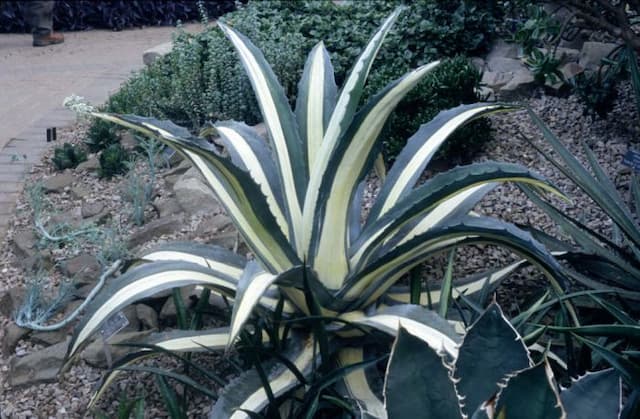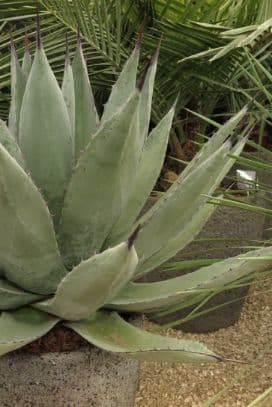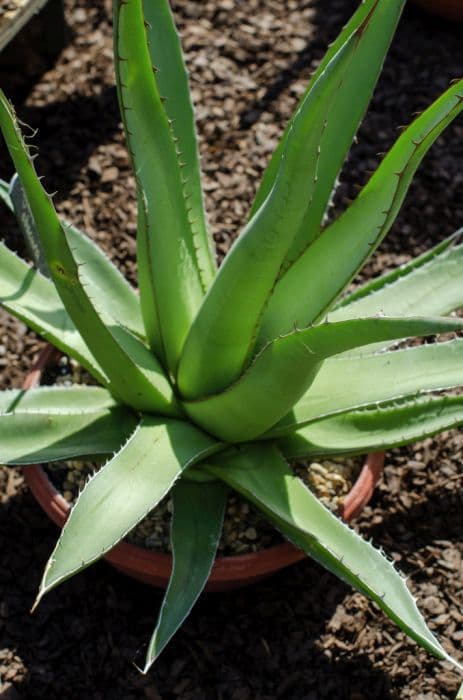Plantain Lily Hosta 'Fragrant Dream'

ABOUT
The Hosta 'Fragrant Dream' is adorned with a lush and attractive foliage display. Its leaves are broad and heart-shaped, providing a full, mounded appearance. The leaf color is a distinct variegation, composed of creamy-white edges that frame a deep green center, creating a compelling contrast. This variegation can give the Hosta 'Fragrant Dream' a vibrant look in a shade garden. During the bloom period, the plant produces lovely flowers that are notable for their fragrance – a quality not found in all Hosta varieties. These flowers rise above the foliage on tall stems and are typically white or lavender in color, adding an extra layer of sensory appeal to the plant. The overall look of the Hosta 'Fragrant Dream' is one of serene beauty, with its combination of decorative leaves and fragrant blooms making it a favorite among gardeners looking to add interest to shaded or semi-shaded areas.
About this plant
 Names
NamesFamily
Asparagaceae
Synonyms
Plantain Lily, Funkia
Common names
Hosta plantaginea 'Fragrant Dream'
 Toxicity
ToxicityTo humans
Hostas, including the 'Fragrant Dream' variety, are generally not considered to be toxic to humans. Ingesting parts of the plant may cause mild stomach upset in some individuals, but significant toxicity or severe consequences are not commonly reported.
To pets
Hostas, including the 'Fragrant Dream' type, are known to be toxic to pets, particularly dogs and cats. If ingested, they can cause symptoms such as vomiting, diarrhea, and depression. In severe cases, ingestion can lead to more serious consequences and potentially warrant veterinary care, although such severe reactions are uncommon. Pet owners should prevent their animals from eating hostas to ensure their safety.
 Characteristics
CharacteristicsLife cycle
Perennials
Foliage type
Deciduous
Color of leaves
Variegated
Flower color
Lavender
Height
1-2 feet (30-60 cm)
Spread
2-3 feet (60-90 cm)
Plant type
Herb
Hardiness zones
3-9
Native area
Asia
Benefits
 General Benefits
General Benefits- Ornamental appeal: Hosta 'Fragrant Dream' has attractive foliage and fragrant flowers that enhance the aesthetic of gardens.
- Shade tolerance: This plant thrives in shaded areas where many other plants would struggle.
- Low maintenance: It requires minimal care once established, making it ideal for busy gardeners.
- Drought resistance: Once established, it can tolerate periods of dryness, though it prefers moist soil conditions.
- Pest resistance: Hostas are generally resistant to pests, though they may occasionally be targeted by slugs and deer.
- Longevity: Hostas can live for many years, providing a lasting addition to the garden.
- Versatility in landscaping: They can be used in a variety of garden designs, including borders, ground cover, and container gardening.
- Suitable for underplanting: This plant can grow under trees and shrubs, utilizing space that might otherwise go bare in the garden.
 Medical Properties
Medical PropertiesThis plant is not used for medical purposes.
 Air-purifying Qualities
Air-purifying QualitiesThis plant is not specifically known for air purifying qualities.
 Other Uses
Other Uses- Leaf Mold Compost: Decomposed hosta leaves create a nutrient-rich compost that can be used to enrich garden soil.
- Hosta Tea Party: The large leaves of Hosta 'Fragrant Dream' can be used as natural, decorative placemats for garden parties.
- Photography Backdrops: The lush foliage provides a green, textured background for photographing smaller plants or garden features.
- Pond Edge Planting: Hostas can be planted around the edges of ponds to create a natural wildlife habitat and reduce soil erosion.
- Creative Leaf Casts: Cement leaf casting using hosta leaves can create unique garden art or stepping stones with intricate leaf patterns.
- Culinary Garnish: Although generally not eaten, the flowers can sometimes be used as an ornamental garnish for certain dishes.
- Natural Mulch: Falling hosta leaves can be left in place to act as mulch, helping conserve soil moisture and suppress weeds.
- Garden Design: Variegated or uniquely colored hosta leaves can be used in shade garden designs to create contrasting textures and colors.
- Container Gardening: Hostas, including Hosta 'Fragrant Dream,' can thrive in containers and add lush foliage to patios and balconies.
- Educational Tool: Hostas can be used to teach children about plant growth, propagation, and the importance of shade in gardening.
Interesting Facts
 Feng Shui
Feng ShuiHosta is not used in Feng Shui practice.
 Zodiac Sign Compitability
Zodiac Sign CompitabilityHosta is not used in astrology practice.
 Plant Symbolism
Plant Symbolism- Resilience: Hostas, often known as Plantain Lilies, are hardy plants that can thrive in a variety of conditions, symbolizing the ability to overcome adversity.
- Self-Care: With their lush foliage that requires shade to flourish, Plantain Lilies remind us of the importance of caring for ourselves by seeking shelter from life's harsher elements.
- Healing: Traditionally, some hosta varieties have been used in herbal medicine. Thus, they can represent healing and restoration.
- Devotion: The way hostas return each year, often growing larger and more robust, can be seen as a symbol of devotion and loyalty in friendships and relationships.
- Tenacity: Hostas can grow under trees and in the shadow of other plants, which symbolizes a tenacious spirit and the ability to grow and prosper even in difficult circumstances.
 Water
WaterHostas, including 'Fragrant Dream', need consistent moisture, but they don't tolerate standing water. Water established plants once a week with about one gallon of water per plant, ensuring you soak the soil deeply to encourage root growth. During hot or dry periods, watering frequency may increase to twice a week. Always water in the morning to allow leaves to dry out during the day, reducing the risk of fungal diseases. Be cautious not to overwater, as this can lead to root rot.
 Light
LightHostas prefer dappled shade, so the ideal spot for your 'Fragrant Dream' would be under the canopy of larger trees or on the north side of a building where it can be protected from harsh afternoon sun. Morning sunlight is acceptable, but avoid intense direct sunlight, especially during the hottest part of the day, as it can scorch the leaves.
 Temperature
TemperatureHostas thrive in a range of temperatures but perform best when the daytime temperature is between 60°F and 75°F. 'Fragrant Dream' can survive temperatures down to around 30°F but should be protected from freezing conditions. Be aware that growth slows down when temperatures exceed 85°F.
 Pruning
PruningPruning hostas like 'Fragrant Dream' typically involves removing dead or damaged leaves as needed to maintain plant health and appearance. The best time for pruning is in the early spring before new growth begins, or in the autumn after the plant starts to die back. Pruning is not frequently required but can help rejuvenate an older plant or control its size.
 Cleaning
CleaningAs needed
 Soil
SoilHostas prefer well-draining, nutrient-rich soil with a pH range of 6.5 to 7.5. A good mix for Hosta 'Fragrant Dream' can be made from equal parts garden soil, peat moss, and perlite or pine bark fines to ensure good drainage and aeration. Adding compost or well-rotted manure will enrich the soil and promote healthy growth.
 Repotting
RepottingHostas, like 'Fragrant Dream', generally need repotting every three to five years, or when they outgrow their current container. Early spring or fall is the best time to repot to lessen stress on the plant, ensuring it has time to establish before extreme weather.
 Humidity & Misting
Humidity & MistingHosta 'Fragrant Dream' does well in average outdoor humidity levels. They thrive in environments where the humidity tends to naturally mirror their native habitats— shady, forested areas. No special humidity adjustments are typically needed for these plants outdoors.
 Suitable locations
Suitable locationsIndoor
Provide shade, cool temps, and moist well-draining soil.
Outdoor
Partial to full shade, rich soil, and consistent moisture.
Hardiness zone
3-9 USDA
 Life cycle
Life cycleHosta 'Fragrant Dream', commonly known as Hosta or Plantain Lily, begins its life as a seed, which upon germination, sprouts into a small seedling with a few embryonic leaves. As it grows, it forms a rosette of large, variegated leaves that spread outwards from a central crown. Throughout the spring and summer, the plant matures and can produce scapes bearing fragrant, bell-shaped flowers, usually in late summer. After flowering, it may produce seeds encapsulated in pods, which disperse to propagate the next generation. In autumn, the foliage dies back as the plant enters a period of dormancy. Each spring, Hosta 'Fragrant Dream' re-emerges from its underground rhizomes, starting the cycle anew.
 Propogation
PropogationPropogation time
Spring to Summer
The most popular method of propagation for Hosta 'Fragrant Dream', commonly known as the hosta plant, is through division. This is typically done in the spring or early fall when the plant is not in active growth. To propagate through division, you would dig up the entire clump of the hosta, ensuring you have a substantial root ball. After removing excess soil, the clump should be carefully pulled apart into smaller sections, each with at least two or three shoots and an adequate portion of the root system. These divided sections can then be immediately replanted into prepared soil, spaced appropriately to accommodate future growth. Watering the new divisions thoroughly will help establish them in their new locations. This method is simple, efficient, and helps to rejuvenate older clumps that may have become too dense.









